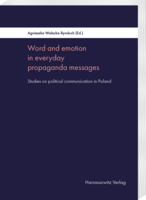|
|
Propaganda as a concept and practice continues to arouse both emotions and research interest. It is difficult to unambiguously define propaganda messages because they are essentially multimodal in nature and represent a variety of methods and media employed to inculcate desirable content in people. A “group mind” and stereotypical thinking play an important role in this. Researchers argue that propaganda influences audiences by shaping mental images of the world aimed to manipulate public opinion, creating a new nomenclature, new tools of influence and new interpretations of ideas.
The 10 contributions focus on selected historical and current processes in Poland to show how one of the main objectives of this type of public persuasion was and is achieved: to persuade as many people as possible to adopt the attitude promoted by the sender of the message. They present various approaches (e.g. new linguistics of propaganda, analysis of visual messages) and multiple aspects of the research subject (such as the mediatization of war, verbal and visual rhetoric, ideological distortion of history), enabling the reader to understand the intricacies of current, daily propaganda messages. The volume also sends a clear signal that reopening the debate on the manipulative mechanisms underlying propaganda actions is especially important in light of the turbulent political landscape in today’s democratic states. |






